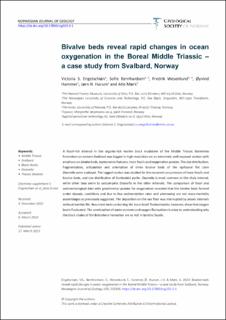| dc.contributor.author | Engelschiøn, Victoria Sjøholt | |
| dc.contributor.author | Bernhardsen, Sofie | |
| dc.contributor.author | Wesenlund, Fredrik | |
| dc.contributor.author | Hammer, Øyvind | |
| dc.contributor.author | Hurum, Jørn Harald | |
| dc.contributor.author | Mørk, Atle | |
| dc.date.accessioned | 2023-08-15T06:39:37Z | |
| dc.date.available | 2023-08-15T06:39:37Z | |
| dc.date.created | 2023-06-09T14:32:16Z | |
| dc.date.issued | 2023 | |
| dc.identifier.citation | Norwegian Journal of Geology. 2023, 103 . | en_US |
| dc.identifier.issn | 2387-5844 | |
| dc.identifier.uri | https://hdl.handle.net/11250/3083964 | |
| dc.description.abstract | A fossil-rich interval in the organic rich marine black mudstone of the Middle Triassic Botneheia Formation on eastern Svalbard was logged in high-resolution on an extremely well exposed section with emphasis on bivalve beds, taphonomic features, trace fossils, and oxygenation proxies. The size distribution, fragmentation, articulation, and orientation of three bivalve beds of the epifaunal flat clam Daonella was analysed. The logged section was studied for the recurrent occurrences of trace fossils and bivalve beds, and size distribution of framboidal pyrite. Daonella is most common in the shaly interval, while other taxa seem to outcompete Daonella in the siltier intervals. The comparison of fossil and sedimentological data with geochemical proxies for oxygenation revealed that the bivalve beds formed under dysoxic conditions and due to low sedimentation rates and winnowing and are not mass-mortality assemblages as previously suggested. The deposition on the sea floor was interrupted by anoxic intervals without benthic life. Recurrent beds containing the trace fossil Thalassinoides however, show that oxygen levels fluctuated. The combination of water currents and oxygen fluctuation is key to understand why the black shales of the Botneheia Formation are so rich in benthic fossils. | en_US |
| dc.language.iso | eng | en_US |
| dc.publisher | Norsk Geologisk Forening | en_US |
| dc.rights | Navngivelse 4.0 Internasjonal | * |
| dc.rights.uri | http://creativecommons.org/licenses/by/4.0/deed.no | * |
| dc.title | Bivalve beds reveal rapid changes in ocean oxygenation in the Boreal Middle Triassic – a case study from Svalbard, Norway | en_US |
| dc.title.alternative | Bivalve beds reveal rapid changes in ocean oxygenation in the Boreal Middle Triassic – a case study from Svalbard, Norway | en_US |
| dc.type | Peer reviewed | en_US |
| dc.type | Journal article | en_US |
| dc.description.version | publishedVersion | en_US |
| dc.source.pagenumber | 0 | en_US |
| dc.source.volume | 103 | en_US |
| dc.source.journal | Norwegian Journal of Geology | en_US |
| dc.identifier.doi | 10.17850/njg103-2-1 | |
| dc.identifier.cristin | 2153347 | |
| cristin.ispublished | true | |
| cristin.fulltext | original | |
| cristin.qualitycode | 1 | |

